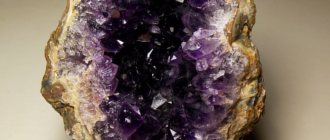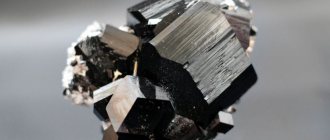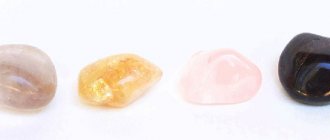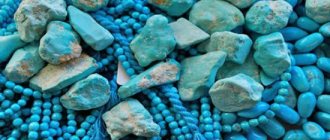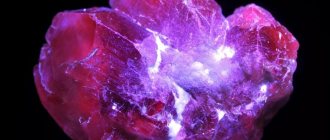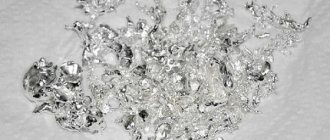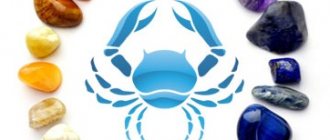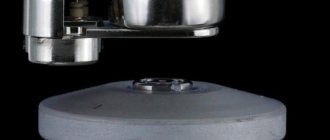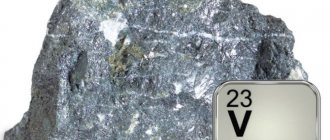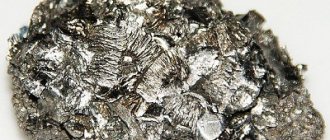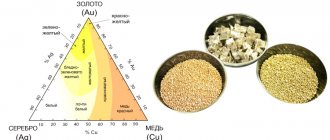Synonyms: Sulfur pyrite , iron pyrite .
Pyrite is the most common sulfide in nature.
The name pyrite is of Greek origin (pyros - fire) and is associated with the ability to produce sparks upon impact.
Photo of an intergrowth of cubic pyrite crystals Ural, Berezovskoe deposit
Geography stories
Columbus, during his first expedition in search of water supplies, came across a certain Yaqui River. Either the Indians laughed at the admiral’s ignorance, or he himself stumbled upon “gold” placers.
He discovered that “the sand at the mouth of the river ... contains a lot of gold, although small, and suggested that the gold grains were crushed along the way from the headwaters to the mouth, and that upstream ... pieces of gold the size of lentils would be found. But there was a huge amount of small gold here.”
The admiral understood little about mineralogy and mistook pyrite placers for gold.
The pyrite gold of the Incas caused pyrite to be contemptuously called “fool’s gold.” They, of course, in this case were the Spaniards.
XVI century, rampant piracy and privateering in the West Indies. Famous pirate captains - Drake, Morgan, Kidd - and stories about disappeared treasures of gold. Treasures of gold buried by pirates could disappear. The pirates were brave guys, but for the most part they were uneducated. They could not distinguish silver from platinum and gold from pyrite. It looks like gold, which means it is. That’s why they buried pyrite instead of gold, but over time it simply turned into goethite or limonite. Real gold, of course, never disappeared.
During the Gold Rush (Alaska), gold was also confused with a mineral similar to it. Jack London wrote about this.
Shiny, golden stones were not ignored by jewelers.
While Napoleon was at war, patriotic women donated their jewelry “for victory” and in return received jewelry made from “fool’s gold.”
Your name, mineral!
The mineral received its current name from the Greek language. "Pyrites lithos" - fire stone. By hitting a piece of pyrite with metal or silicon, you will get a shower of sparks. By the way, for many centuries, pyrite worked for the benefit of people - it helped make fire. Pyrite was used as a lighter or matches.
Pyrite had other names. At different times his names were:
- health stone;
- alpine diamond;
- Inca stone;
- fools' gold;
- cat gold;
- sulfur pyrite;
- iron pyrite.
- In English, pyrite is fool's gold.
For mineral lovers: cat gold is also called one of the varieties of biotite - bauerite. The bronze-colored flakes of this mica can easily be mistaken for gold. Although it’s easy to check - a flake of gold will crumple under pressure, bauerite will break and crumble.
We recommend: MERGEL - breadwinner, builder
Physics and chemistry of pyrite
The chemical formula of the mineral pyrite is FeS2, iron disulfide.
Pyrite often contains impurities:
- cobalt;
- nickel;
- arsenic;
- copper;
- gold;
- Selena.
Physical properties:
- The shine is bright, metallic.
- Hardness 6-6.5 on the Mohs scale.
- The color is brass or straw yellow.
- The color of the trait is brownish or greenish-black.
- Opaque.
- Density 5000 kg/m3.
In nature, pyrite looks different: it appears in the form of crystals - cubic, octahedral and other types of crystals. It can be released in the form of stalactites, nodules, or continuous granular masses.
The color on chips can change from light to dark yellow and becomes tarnished. This not very clear word refers to the rainbow tints on the surface of the stone. Shimmer (tarnish) occurs when rays of light fall on the surface of a stone, and when reflected, they “come out” on a different path than they entered. Thus, pyrite becomes not only a “golden” stone, but also a rainbow stone.
In air, pyrite oxidizes, turning into limonite or goethite. The golden color gives way to brown.
Pyrite formula
FeS2
Chemical composition of pyrites
Theoretical composition - Fe - 46.55%, S - 53.45%. It often contains very small amounts of impurities: Co (cobalt pyrite), Ni, As, Sb, Se, sometimes Cu, Au, Ag, etc. The content of the latter elements is due to the presence of mechanical impurities in the form of tiny inclusions of foreign minerals, sometimes in a finely dispersed state. In these cases, we are essentially dealing with solid pseudosolutions—crystal sols.
Mixed crystals or varieties: bravoite or nickel-pyrite (Ni, Fe, Co) S2, a0 = 5.50 - 5.58 * 3; villamaninite (Cu, Ni, Co, Fe) (S,Se)2, a0 = 5.66
Melnikovite - pyrite is a cryptocrystalline pyrite of gel-like origin. Laurite has a low osmium content;
Auerite exhibits a strong non-metallic character, probably due to its diamond-like bond.
Varieties of pyrite
- marcasite, radiant pyrite. It has a different crystal structure - radiant-radial;
- bravoite - its nickel content reaches 20%, which automatically makes it nickel ore. The color is pale yellow with a slight reddish tint.
In the Middle Ages, they did not distinguish between pyrite and marcasite. All sulfur pyrite minerals in Eastern and European mineralogy were called marcasite, marcasis. Modern mineralogists believe that golden marcasite corresponds to copper pyrite, silver to marcasite itself, and copper to pyrite.
Interesting: the best examples of blue lapis lazuli are decorated with inclusions of pyrite, which, of course, was mistaken for gold.
Form of being in nature
In numerous rocks and ores, pyrite is observed in the form of disseminated crystals or rounded grains. Solid aggregate structure pyrite masses are also widely developed. Sometimes it forms drusen.
The appearance of crystals . Crystals are widespread, mainly cubes, pentagondodecahedrons or octahedra.
a - hexahedron (cube) cube a {100} b - pentagondodecahedron e {210}
g - octahedron o {111}
d - a combination of an octahedron (o) and a pentagondodecahedron (e) - the so-called mineral icosahedron
Pyrite crystal shape:
- a - cube a {100};
- b — pentagondodecahedron e {210};
- c - the same shape in combination with cube a {100};
- d - octahedron o {111}, blunted by the faces of the pentagondodecahedron;
- d - a combination of an octahedron (o) and a pentagondodecahedron (e) - the so-called mineral icosahedron (a combination of an octahedron with a pentagondodecahedron).
The dimensions of the crystals sometimes reach several tens of centimeters in diameter.
Characteristic is the streakiness of the faces parallel to the edges of the cube (100) : (210), i.e. a : e . This streakiness is in accordance with the crystal structure (the arrangement of sulfur atoms in the structure) and is always oriented perpendicular to each adjacent face, i.e., the external elements of symmetry are fully consistent with the features of the structure.
Pyrite is very characterized by growth twins along {110}, rarely along (320).
Regular intergrowths between pyrite and marcasite, tetrahedrite, galena, pyrrhotite, arsenopyrite, etc. are known.
Pyrite crystals formed at high temperatures are usually poor in simple forms. The latter are usually represented by cubes, octahedra or {210}. The same is true for low-temperature formations, while crystals arising at intermediate temperatures and depths are richer in simple forms. In such deposits, crystals up to 10 cm in size are found. According to Sanagawa, the crystalline habit of pyrite depends on the size of the crystals. Smaller crystals are predominantly cubic, while larger ones are pentagon-dodecahedral. Detailed studies carried out by the same author on numerous deposits in Japan showed that in metasomatic deposits cubic pyrite crystals are characteristic of the highest and lowest temperature zones.
Pentagondodecahedrons are typical of low-temperature but intensely mineralized zones. Crystals of pentagondodecahedral habit are formed in intermediate situations. This is consistent with the sequence of development of the main types of pyrite habit. The cubic habitus is typical for weak supersaturations, the pentagondodecahedral one for high supersaturations, and the octahedral one for intermediate ones. The occurrence of crystals of pentagon-dodecahedral and octahedral habit in vein deposits and cubic habit in bedrock, usually in the form of inclusions, can be interpreted in terms of supersaturation. A definite relationship between the crystal habit and impurities has not been established. Under reducing conditions, nodules or dissemination of pyrite are often formed in sedimentary rocks
Under sedimentary conditions, a cryptocrystalline variety of pyrite (melnikoeite) is also deposited, forming mixtures with a dimorphic modification of FeS2 - marcasite. The latter mineral is rhombic, artificially obtained in an acidic environment, while pyrite is formed only in a neutral or slightly acidic environment. Pyrite can occur through metamorphism from clayey sediments enriched in organic material. Pyrite is mined to produce sulfuric acid, mainly from the world famous Rio Tinto mine in Spain.
Aggregates. The most common are dense, confluent and granular masses, as well as kidney-shaped, cod-shaped discharge; coarse-fibrous, thin-stalked, radial formations, often pyritized rock layers.
In sedimentary rocks, spherical nodules of pyrite are often found, often with a radial structure, as well as secretions in the cavities of shells. Grape or kidney-shaped formations in association with other sulfides are common.
Firestone deposits
Iron disulfide is widespread in the earth's interior, and among sulfides it ranks first.
This is one of the main ores for the production of cobalt, gold, thallium, and selenium.
But, of course, we are interested in whether it is possible to make jewelry from fire stone. Can. But not all, not any. But collectible druses and pyrite crystals are in demand among mineral lovers.
Firestone is mined in many places on the planet. This:
- Afghanistan;
- Kazakhstan;
- Spain;
- Finland;
- Mexico;
- Poland;
- USA;
- China. The list goes on...
Large Russian pyrite deposits:
- Irkutsk region;
- Karachay-Cherkessia;
- Moscow region;
- Karelia;
- Krasnoyarsk region;
- Primorsky Krai. It’s difficult to list everything.
You can find crystalline collectible pyrite in the Urals. Interesting samples are brought from Peru, Azerbaijan, Congo, Austria, and Italy.
The mineral often forms pseudomorphs from petrified wood, ammonites, and other organic remains. Such specimens would be the pride of collectors if they were kept for a long time. But alpine diamond decomposes in air, and this process cannot be stopped, only slowed down. To do this, it is boiled in paraffin, in rosin, soaked in vegetable oil, varnished... Storage in a vacuum display case is not cheap.
Pyrite formula, origin, chemical composition.
The natural mineral pyrite is the so-called sulfur or ferruginous pyrite, which is considered the most common sulfide mineral. In this case, the formula of pyrite is FeS2 (46.6% Fe, 53.4% S). Formation occurs during a variety of geoprocesses: magmatic, sedimentary, hydrothermal, etc.
The crystals are found almost everywhere and are commonly found iron sulfides. This natural mineral usually comes in the shape of a cube and often has completely smooth, as if polished, mirror-like edges. There are also samples in the form of granular masses.
This natural gem is present in rocks of various etymologies. Metasomatic rocks contain a particularly significant amount of it. Sedimentary rocks also mainly consist of pyrites and silicon. In magmatic ones, it enters as an accessory substance (in scanty volumes). Natural pyrites often form pseudomorphs after ancient fossils such as ammonites.
Usually pyrites are found in the form of beautiful intergrowths and separately formed crystals. The most common shape of natural pyrite crystal samples is cubic. The stones are so perfectly formed and cut by nature that it is difficult to understand that this was not processed by a master. Sometimes you come across specimens containing microscopic inclusions of gold and other metals.
Rocks of the sedimentary group often contain natural pyrites, which replace the remains of dead animals and plants. At the same time creating unique fossilized forms in the form of shells and entire pieces of fossil trees.
Application: from cast iron to figurines
The importance of pyrite for industry (and therefore for our comfortable life) is great.
- For many years, the production of sulfuric acid was impossible without firestone.
- Pyrite consists of two elements - iron and sulfur. So they get iron and cast iron from it, Alpine diamond.
- Sulfur was also previously extracted from firestone. Nowadays it is mainly obtained as a by-product of oil and gas refining (a headache for oil workers is sulfurous oil).
- Sulfuric acid is also easy to obtain from pyrite by reacting it with oxygen.
- Oxidative roasting of iron disulfide - and you get iron sulfate. If you don’t know what it is, it means you’re not a summer resident, not a gardener, and you haven’t had iron deficiency anemia.
- Jewelers are trying to use the shine and resemblance to gold of this mineral.
We recommend: The meaning and properties of QUARTZ DRUZ
They tried to make watch cases, trinkets, umbrella handles, boxes, and figurines from “clown gold.” However, the capricious mineral in a humid climate quickly rusted, darkened, and lost its marketable appearance.
That’s when museum curators came up with the idea of boiling items made from “Inca gold” in paraffin or covering them with colorless varnish—the jewelry became safe to wear.
Physical research methods
Differential thermal analysis
Differential thermal analysis. DTA curve
The main lines on X-ray diffraction patterns of pyrite:
2,696(8) — 2,417(8) — 2,206(7) — 1,908(6) — 1,629(10) — 1,040(9)
Ancient methods. Under the blowpipe, the pitite cracks and melts into a magnetic ball on the coal, causing a bluish flame to appear and smoke to be released. Easily loses some of the sulfur, which burns with a blue flame. In a sealed tube, part of the sulfur sublimes, leaving FeS monosulfide.
Firestone magic
The Spartans (and they were raised for war) were confident in the magical power of pyrite amulets. They bestowed boundless courage, courage in battle, and protected from betrayal.
The magical properties of pyrite were previously used by alchemists. Now the magic of the Alpine diamond is held in high esteem by modern magicians and sorcerers.
But the stone will also help ordinary people become more self-confident and reveal leadership qualities. Your mood is at zero, you shy away from work - pyrite will help. It will lift your spirits, invigorate you and give you vitality. That's what esotericists say, in any case.
Pendant with pyrite
Nowadays, the pyrite talisman is a good talisman for firefighters and military personnel, emergency workers, and police officers.
Information for men: pyrite will provide you with victories on the love front.
The mineral is solitary by nature and cannot stand the proximity of other stones. Compatibility with other stones in jewelry (from the point of view of magical properties) is out of the question. The exception is serpentine and hematite.
A gold-like mineral attracts money to the home and to the owner of the jewelry.
Just don’t wear the jewelry for more than 3-5 days in a row - the powerful magic of the fire stone can harm a person.
Magical properties of the stone
Since ancient times, man has seen in stones something more than just the earth's surface. For example, pyrite has always been considered a “male” mineral. Ancient Greek warriors took it with them on campaigns and battles. It was believed that in battle this pebble could prevent the brazen death of a soldier.
The modern magical meaning of pyrite has remained virtually unchanged. It is often used as an amulet or protective talisman. The stone can improve a person’s mood, strengthen his sleep and banish depression. True, in order to properly perform its magical “duties” the mineral must be perfect - without chips or cracks.
Sulfur pyrite is a fire stone. Therefore, it is most suitable for the corresponding zodiac signs - Aries, Leo and Sagittarius. But Rakov doesn’t really like pyrite. The stone does not get along well in proximity to other minerals. The only exceptions may be hematite and serpentine - pyrite will make friends with these stones.
We treat with pyrite without fanaticism
Pliny the Elder wrote that powdered pyrite is used to treat ulcers and goiters, hence another name for the mineral - a stone of health.
Following the scientist’s instructions, in ancient times healers sprinkled crushed pyrite on ulcers and abscesses. Ointments with it were used to relieve joint pain.
Lithotherapists include the following medicinal properties of Alpine diamond:
- Positive effect on the nervous system.
- Help in the fight against depression and mania.
- Normalization of the balance of processes in the body.
For iron deficiency anemia, stone experts advise wearing jewelry made from “Inca gold.” They will increase the amount of oxygen in the blood and accelerate its delivery to tissues and organs. This seems to be true - it’s not for nothing that the mineral is used in the manufacture of medicines for anemia.
We recommend: SPINNER - the beauty and deceit of the skin of the Great Snake
Easily excitable people are not recommended to wear jewelry with a fire stone.
Properties of pyrites
The structure of pyrite is octahedral with characteristic skeletal shapes and radial aggregates. They are characterized by a metallic luster and original coloring , predominantly grey, red and yellow. Despite the fact that all types of pyrites have excellent hardness, they belong to the group of brittle minerals endowed with systems of rhombic or hexagonal structure:
- Rhombic variants are represented by marcasite and arsenic pyrites.
- Minerals with regular systems include ulmanite, pyrite, chloanthite, slake cobalt and cobalt luster.
- The hexagonal system is inherent in magnetic pyrite, nickel and millerite.
- Copper pyrite has a standard square shape.
Stars for pyrite
The patron planet of the fire stone is Mars. Elements - Earth, Fire.
Pyrite stone has a masculine origin.
Astrologers are wary of “clown gold.” It's a matter of contradictions. Some believe that pyrite is not a patron of any zodiac sign at all. Others cautiously say that for fire signs according to the horoscope (Aries, for example), it is quite suitable. Still others generously give the location of the fire stone to Scorpios, Virgos, Sagittarius...
Supporters and opponents of different theories agree on one thing - it is better not for anyone to wear stones with cracks or chips.
Chemical properties
It dissolves with difficulty in HNO3, decomposes with difficulty (easily in powder), releasing sulfur. Insoluble in dilute HCl.
Other properties
Pyrite conducts electricity poorly. Refers to paramagnetic minerals. Thermoelectric. Some varieties have detector properties.
Diagnostic signs
Well recognized by color, crystal shapes and streakiness of edges, high hardness (the only widespread sulfide that scratches glass). Based on the combination of these characteristics, it is easily distinguished from marcasite, chalcopyrite, pyrrhotite, arsenopyrite, gold and millerite, which are somewhat similar in color.
Associated minerals. The satellites are vartz, calcite, chalcopyrite, galena, sphalerite, gold, gold tellurides, arsenopyrite, pyrrhotite, wolframite, stibnite.
Galena, pyrite. Druse of crystals
About jewelry with pyrite
In jewelry, pyrite products came into fashion in the 20th century thanks to the company Butler & Wilson. The company's jewelers created exclusive jewelry from pyrite, a simple ornamental stone. The “pyrite fever” began with them.
Jewelry with pyrite
Our “Alpine diamond” is a democratic mineral. It can be worn “to a feast, and to the world, and to good people.” Of course, if you appeared at high-status parties wearing jewelry made of “clown’s gold,” people might not understand you.
But in autumn or spring bad weather, the joyful golden-yellow color of the mineral will give you vigor.
For women, earrings paired with a pendant are suitable. A man will be decorated with a bracelet with pyrites. Young fashionistas will love baubles with a yellow, sunny stone.
How much is jester's gold worth?
The cost of the figurines depends, of course, on the fineness of the work, the price of the frame, the size of the figurines and how highly the master values his work.
- A 1x1 cm cube of pyrite sells for 90 to 120 rubles.
- Pyrite beads will cost 2,000-3,500 rubles.
- Balls on a stand (feng shui experts place them in the wealth sector - the southeastern part of the room) are valued depending on their size. The smallest one will cost 2,500 rubles. If you want more, no problem. Question of money.
- They sell elephants and money frogs to attract good luck, wealth and other joys of life. A cute elephant (10x8x5 cm) can be purchased for 12,000 rubles.
- Collectors will appreciate the polished, processed section of a pyritized ammonite. A rather large exhibit, 28x25x3.5 cm, costs about 30,000 rubles.
Unprocessed pyrite is sold at a price of 0.01-0.2 US$ per gram.
Is it worth counterfeiting pyrite?
Yes, “fool’s gold” is also counterfeited. In the most primitive way - plastic or coated glass - here you have that “gold”. No need to process fragile stone. And the prices for fakes are simply shameless. A thread of glass or plastic that imitates pyrite will sell for 600-700 instead of a hundred rubles.
It's easy to spot a fake. Look at the light - real iron disulfide is always opaque. You can run your fingernail over the surface of the product. The coating is always thin, and if a scratch is formed, this means that they are “making a fool” of you.
Related publications
- RAUCHTOPAZ: smoky chameleon stone
- Solution Stone WHITE JADE
- Application of SNOW QUARTZ
- SAPPHIRE STONE
Application
Pyrite.
Impregnation in argillite. Rostov region iron pyrite cabochons Pyrite ores are one of the main types of raw materials used to produce sulfuric acid. The average sulfur content in ores exploited for this purpose ranges from 40 to 50%. Ore is processed by roasting in special furnaces. The resulting sulfur dioxide SO2 is oxidized with nitrogen oxides in the presence of water vapor to H2SO4. An undesirable impurity in ores used for sulfuric acid production is arsenic.
Copper, zinc, sometimes gold, selenium and others, often contained in pyrite ores, can be obtained by secondary methods. The so-called iron cinders obtained as a result of firing, depending on their purity, can be used to make paints or as iron ore. Ores containing cobalt pyrite are the source of approximately half of the cobalt consumed in the world, despite the low content of this element in them (up to 0.5–1% in the mineral)
Inserts for jewelry are made from pyrite from the Berezovsky deposit in the Urals.
Pyrite is mainly cut into cabochons.
